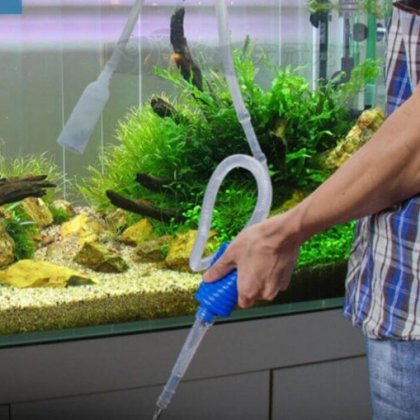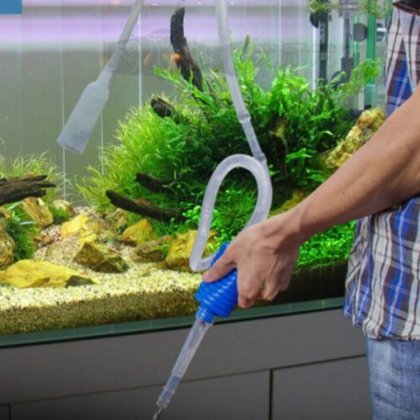Betta Aquarium Care, Feeding and Native Habitat Information
The male Betta is one of those iconic fish species that is easily recognized to both aquarium hobbyists and non-hobbyists alike. Their bright coloration, long flowing fins and unique appearance have made them very popular for decades and arguably one of the most popular fish species among aquarium hobbyists. Bettas originate from shallow waterways, flood plains, rice paddies and streams in many parts of Southeast Asia including: Thailand, Indonesia, Malaysia, Vietnam and parts of southern China. Since Bettas come from shallow water environments, most hobbyists assume that they can stand low water quality and quick changes in environment. However, the part of the world that Bettas come from has very consistent warm tropical weather and plenty of rainfall to dilute even shallow water and keep the water quality high and temperature stable. Thus Bettas need an environment with warm water temperatures (75-86� F) and fairly stable water conditions. Although Bettas are often sold in small bowls in fish stores, for best care, Bettas should be kept singularly in aquariums of at least 1 gallon, with plenty of vegetation to provide them a vegetarian food source and places to hide when they feel threatened. Bettas are often referred to as Fighting Fish or "Siamese" Fighting Fish, since it has been bred over the years to be both colorful and combative, especially towards other males. As such, only one male Betta should be kept in an aquarium. The Betta should be housed with peaceful fish that will not nip at the Bettas long flowing fins.
While Bettas can do well in waters low in dissolved oxygen, that does not mean they require less oxygen than other fish. Bettas have a special respiratory organ that allows them to breath air directly from the surface. In fact they inherently must do so. In experiments where the labyrinth organ was removed, the fish died from suffocation even though the water was saturated with oxygen. For this reason, Bettas must have access to the water surface to breath air directly from the atmosphere. Optimal water for keeping healthy Bettas should be soft, warm, with a neutral to slightly acidic pH. To mimic their natural environment, water movement should be low, or in the case of a larger aquarium, they should be provided calm areas within the tank including calm areas near the surface of the water. Bettas may be kept in a community tank as long as their water conditions are met, and no aggressive or fin-nipping fish are present. However, only one male may be kept in each aquarium, unless they are separated by a barrier. Bettas will appreciate aquariums with plenty of live plants or synthetic plants made from plastic or silk to provide them a more natural habitat.
In nature Bettas subsist almost exclusively on eating insects and insect larvae, which is why they have an upturned mouth that is well suited to snatching their insect prey that might fall into the water. Internally their digestive system is geared for meat, having a much shorter alimentary track than vegetarian fish. For this reason, live foods are the ideal diet for the betta, however they will adapt to eating flake foods and frozen and freeze dried foods including: brine shrimp, daphnia, plankton, tubifex, glassworms, and beef heart, are all excellent options that may be found frozen or freeze dried. If flake food is fed, it should be supplemented with frozen and freeze-dried foods, and if possible live foods.
Bettas can be successfully bred by average aquarists using small aquariums of about 10 gallons in size. Young Betta of approximately 1 years or less in age are ideal for breeding as their fertility and willingness to breed decrease with age. Typically Betta sold in pets stores are around 6 months in age, so they should be bred within 6 months of purchase. Ideally the Betta should be conditioned prior to breeding, by feeding them a diet of live foods, and they should be kept in water with a pH of about 7.0, and temperature around 80 or slightly above. When he is ready to breed the male will build a bubble nest at the waters surface, where the deposited eggs will be kept until the hatch. The female should be provided with a hiding place, as males may become aggressive during courtship. Even with a hiding place, it is common for the female to lose a few scales or have their fins frayed during spawning.
When they are ready to spawn, the pair will display intense coloration and begin circling each other under the bubble nest. The male will wrap himself around the female who has turned on her back. As the female expels the eggs, they are fertilized and begin to sink, at which time the male will scoop up the eggs and spit them into the bubble nest. It is best to remove the female after breeding has taken place, as the male will tend to the young and may become aggressive towards the female. After the young have hatched they will feed off of their yolk sacks for about 36 hours. The adult male betta should be removed within 2 days of the young hatching so that they do not eat any of the newly hatched fry. The fry should be fed a couple of feedings daily of baby brine shrimp or very fine baby food. Take care not to overfeed, as the uneaten food will foul the water and can quickly prove lethal to the fry.
Quick Facts :
Care Level:Easy
Temperament:Peaceful
Maximum Size:3"
Minimum Tank Size:1 Gallons
Water Conditions:75-86° F, KH 0-25, pH 6.0-8.0
Diet:Carnivore
Origin:Southeast Asia
Family:Belontiidae
Species:Bettas
Aquarium Type:Community
No reviews found!













































No comments found for this product. Be the first to comment!